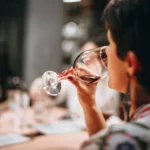First, how many oz in a glass of wine?
Any beverage with 13.7 grams or 1.2 tablespoons of pure alcohol (about half an ounce) is considered a standard drink. 5 ounces of wine typically contain this much pure alcohol.
To put this into perspective, given that a bottle of wine is 750ml, or 25 ounces, there are roughly 5 glasses of wine in a bottle. When reading health-related news, it’s always a good idea to read the fine print because different medical studies around the world may have different definitions of what constitutes a glass of wine.
Please continue reading as I explain the particular information in the post.
Table of Contents
What Is A Standard Drink?
First things first: what exactly is a standard pour and why on earth is it a thing? To be completely honest, there is no such thing as a standard pour. *Insert audible gasp here* Well, obviously it exists because we are writing about it right now. But what we really mean is that, regardless of whether you’re with a sommelier in Napa or at a hip bistro in New York, there are no official CDC or FDA regulations in the US regarding what constitutes a pour of wine at a bar or restaurant. This is most likely the case because, if it did, over-pouring would be prohibited and bartenders and restaurant employees would need to possess some kind of specialized license issued by the government. Identify what we are saying: there are no regulations on standard pours, and maybe that’s a nice thing. Although 750 ml bottles are the standard size for wine bottles, the standards for fluid ounces vary depending on the type of wine. Despite the standard 750 ml wine bottle size being the most common, there are still many different sizes of wine bottles. So you can imagine the variety of pinot noir and chardonnay options you have!
However, when it comes to the unrestricted standard pour, a lot of people—including ourselves—are shocked to learn that their serving of wine is actually much more than a standard drink. The amount of liquid in your glass, can, or bottle does not always correspond to the amount of alcohol in your beverage. The alcohol content of various beers, wines, and spirits can vary. Light beers, for instance, have a similar alcohol content to regular beers. See why it’s important to be aware of the alcohol content of your serving size?
One standard drink, or what would be considered one alcoholic beverage, in the United States contains about 14 grams of pure alcohol. What exactly is in popular drinks then? For beer, that equates to twelve ounces of regular beer, which typically contains 5% alcohol. That amounts to five ounces of wine with a 12% alcohol content. That amounts to one and a half ounces, or about 40% alcohol, of the “hard stuff,” also known as distilled spirits.
How Many Oz In A Glass Of Wine?
So, the truth bomb that hurt us the most was this. We must have poured far more wine than the typical five-ounce pour at home. White, red, rose, and sparkling wines are all subject to this fee. Evidently, there are many different types of glassware present, so it might seem strange that there is a standard pour. The common beverage does, however, aid in taking stock, which is one of its purposes. The standard pour is also used to maintain consistency in drinks from round to round as well as the flavor balance of each drink. The things you discover while writing Bev blogs are absolutely mind-blowing. See more about How Many Ounces Are In A Wine Bottle?
The Importance Of Knowing The Oz In Wine Glasses
A large glass may be to blame for your excessive wine pouring, according to studies. According to research, we pour 12% more wine than usual when using larger wine glasses.
“The amount of alcohol that consumers consume is frequently unknown. It’s less obvious how much each person consumes, particularly when they purchase a bottle of wine. And when people pour on top of wine still in a glass, that bias increases by a lot,” said Laura Smaradescu author of Substance Use and Misuse, in an interview with USA Today.
Knowing the type of wine glass you’re using will help you determine how many ounces it can hold and enjoy the wine’s fullest flavor and aroma.
For instance, red wine glasses are made with that bowl-shaped globe and a larger, taller frame. Since red wine is frequently robust and aromatic, they are created in this manner. Additionally, the wine glass’s rounded shape contributes to the preservation of those flavors.
White wine glasses, on the other hand, look slimmer and have a narrower stem. White wines are frequently delicate, which is why this is the case. The delicate flavor and aroma of the wine can be preserved in the small, narrow bowled glasses.

Bottle Formats & Their Corresponding Volumes
Priority one should be given to the various wine bottle formats when discussing volume and wines. Wine bottles come in a variety of sizes, with the standard wine bottle being the most popular at 750mL, or 0.75 liters, or 25.4 fluid ounces.
The 187.5 mL “Split bottle” and the 375 mL “Half-Bottle,” which make up one fourth and one half of a standard bottle format, respectively, are formats that are smaller than this standard format.
Formats that are larger than the standard 0.75mL bottle are referred to as Large Format bottles, and at As one of the largest collections of these uncommon formats in the nation, Millesima USA has a wide range of formats. Two of them are the 1.5 L (50.7 ounce) Magnum and the 3L (101.4 ounce) Double-Magnum, each of which holds two standard bottles. Six standard bottles fit inside the 4.5L (152.1 ounce) Jeroboam.
The 8 standard bottles fit inside the 6L (202.9 ounce) Imperial. Twelve standard bottles fit inside the 9L (304.3 ounce) Salmanazar. 16 common bottles can be stored in the 12L (405.8 ounce) Balthazar. And the magnificent 15L (507.2 ounce) Nebuchadnezzar holds a whopping 20 standard bottles.
These wines are created for the most memorable occasions in life. We will use the term “wine bottle” to refer to the 0.75 mL standard wine bottle throughout the rest of this article.” See more about How Many Calories In A Bottle Of Red Wine?
What Is The Maximum Volume A Standard Wine Glass Can Hold?
Next, let’s discuss typical wine bottles and glasses. Red wine glasses come in a variety of sizes and shapes, but the typical red wine glass has a total capacity of 12 to 16 fluid ounces, or 360 to 473 milliliters, of wine. The standard white wine glass holds 12 fluid ounces (or 360mL) of wine, though there are many different varieties. Technically speaking, you could fit almost the entire bottle of wine into just two glasses. Perhaps you shouldn’t, though; that’s a bit excessive.
A Standard Wine Pour Has How Many Fluid Ounces?
We advise serving the typical pour size rather than pouring your entire bottle into two glasses of wine. According to the FDA, USDA, and CDC guidelines, this keeps the alcohol level within the acceptable range. It also gives you room to swirl the wine in the glass, which enhances the aromas it has to offer. A 5 ounce glass of wine (or 147 mL) is considered one serving in the US.
The standard bottle thus holds enough wine for five 5-ounce glasses. A magnum bottle of wine holds ten wine glasses. Twenty wine glasses can fit inside a double-magnum bottle. You get the idea…

Variations On The Standard Pour Of Wine
Let’s take a closer look at the few occasions when the wine industry veers from the customary wine pour. They are the usual pours for wine tastings, fortified wines, and dessert wines.
How Many Ounces Does A Dessert Wine Pour?
Two ounces is the standard pour for dessert wine. Undoubtedly a smaller serving size, but that’s because it’s usually intended to be enjoyed similarly to a sweet dish. when consumed sparingly and for its sweet flavor profile.
What Is The Typical Pour Of Fortified Wine?
Standard pours for fortified wines like port and sherry are around 3 ounces. They contain more alcohol than regular, unfortified wine and are thus enjoyed as such, clocking in at about 20% ABV.
What Is The Pour Size For Wine Tasting?
The typical wine pour size for a wine tasting is about half of a standard pour. Therefore, a wine tasting pour size is roughly 2.5 ounces if a standard wine pour is 5 ounces. Many people aim for a pour that is between 2 and 3 ounces when they pour wine for tasting. It is not required to be precise.
How Much To Pour In A Wine Glass
It’s a little different from measuring other types of alcohol how much wine typically pours. For wine, nobody uses a jigger. But there are a few extremely creative solutions.
A wine pourer is the first. Similar to a liquor pour spout, but made specifically to control wine flow The best wine pourers make it simple to achieve the ideal wine pour.
Wine glasses with pour lines are up next. These nifty little suckers tell you exactly where to stop pouring to hit the typical wine pour.
But when pouring wine, the majority of people typically stick to free pouring. And if you choose that path, there is a trick you can use to get the perfect wine pour. It serves as an intangible yardstick. On most wine glasses, thanks to the glassmakers who make them, the widest point of a wine glass typically corresponds to the 5- or 6-ounce mark.
You won’t overpour wine again if you keep this in mind as you serve it. In case you accidentally overpour, keep some wine stain remover nearby to prevent ruining your clothes.

Does The Rule Always Apply?
There are, after all, exceptions to almost every rule. There are a few situations where alcohol pours differently than wine would normally. These are typically used when pouring wine for dessert wine, fortified wines, and wine tastings.
A two ounce dessert wine pour is typical. Dessert wine is enjoyed in much smaller glasses than a typical pour because it is meant to be enjoyed like a dessert and has a delightful, albeit incredibly sweet, flavor.
Standard fortified wine pours differ from five ounces because of variations in wine content, similar to sweet wine. Contrary to dessert wine, it is not because of its sweet flavor but rather because of its high ABV. These wines have a high ABV of 20%. In light of this, three ounces is the recommended serving size.
Finally, the size of the wine pours for tasting. These are obviously smaller because of the amount of wine that tasters will consume. Furthermore, wine does have a cost. The typical wine tasting pour weighs 2.5 ounces. However, wine tasting pours can vary depending on the specific tastes.
We can continue if you still feel the need for more details on typical wine pours. Here’s an insider tip that’s probably just common sense and not really all that insider: training restaurant staff and barkeepers to pour a standard table wine pour and liquor is a big way to help your business costs down.
Which Glasses Ought To You Be Using?
There are many different wine glassware types available, as you may have noticed if you have ever visited a home store or have been alive for longer than five minutes. However, the following is the reality regarding wine glass shape and its effect on wine flavor: it has not been demonstrated that it has any effect. Some contend that a glass’s shape is significant because it concentrates the wine’s flavor and aroma and highlights its distinctive qualities. The majority of wine glasses have a bowl, stem, and foot but are stemless.
The typical white wine glass holds eight to twelve ounces, while the typical red wine glass holds eight to twenty-two ounces. Ever wonder why white wine glasses are so much smaller than red wine glasses? The rumor is that red wines that are older, fuller-bodied, and higher in tannin aerate best when spread across a larger surface area. The wine aerator brings out the best flavor of your wine, which is why people use them. See more about How Many Glasses Are In A Bottle Of Wine?
Why Is It Important To Know Wine Math?
If you’ve read this article to the end, you may be wondering, “But why is it important for me to know about wine ounces and wine standard pours?”” Simply put, wine math is useful when trying to organize a wine tasting event, such as a dinner or party. We advise having enough wine for three glasses per person just to be safe, as the typical amount of wine consumed per person at an event is two glasses. For instance, the wine math for 5 guests would be: 6 people (including you) x 3 standard pours x 5 ounces of wine = 90 ounces of wine needed
This means 3.54 standard bottles (rounded up to 4 bottles) or 1.7 Magnum bottles (rounded up to 2 Keep in mind that this quantity will need to be adjusted depending on the type of wine you serve (e.g., two Magnum bottles). To put it another way, it might need to be changed depending on whether you’re serving a high-alcohol wine or a light wine.

How Many Wine Glasses Are There In A Bottle?
Around 25.3 ounces make up a typical 750ml wine bottle. Therefore, if you do the math, one bottle can make about five glasses of wine. The precise number of glasses will be visible if you are pouring properly. However, the serving may change if you pour too little or too much. Read more about How Many Glasses Are In A Bottle Of Wine?
How Many Oz Is The Ideal Serving of Wine?
Any type of wine glass should hold 5 oz, or about 150 ml, of wine as the standard pour. Again, you shouldn’t go over this amount per serving whether you’re using a red wine glass or a white wine glass.
Variations In Wine Glass Oz Serving
The recommended pour in wine glasses is 5 oz, but this can change depending on the use. Dessert wines, fortified wines, and wine tastings all have different serving sizes.
Dessert Wines
2 ounces is the recommended pour size for dessert wine. Although this is quite a small amount, dessert wines should also be fully enjoyed in small portions, just like desserts served in adorable sizes.
Fortified Wines
An appropriate serving size for fortified wine is 3 ounces (88 ml). This can change depending on the wine’s alcohol content, but it is typically around this level.
Wine Tastings
Half of the serving size is used for a typical tasting pour. As a result, the tasting size is 2 or 3 oz if the standard pour is 5 oz.
The Bottom Line
While wine types affect average pours differently, glassware does not. That would be 5 ounces of regular wine. 3-ounces of fortified wine. 3 ounces for wine sampling Then 2 ounces of dessert wine.
The pour cost of your bar can be greatly reduced by providing servers with training on standard wine pours and standard liquor pours, especially if your wine menu or digital wine list features wine by the glass. The advantages that a standard recipe has in the kitchen are the same here. The guests are primarily irritated when a bottle is overfilled at the table.
I want to thank you for reading, but that’s not the end of it.









